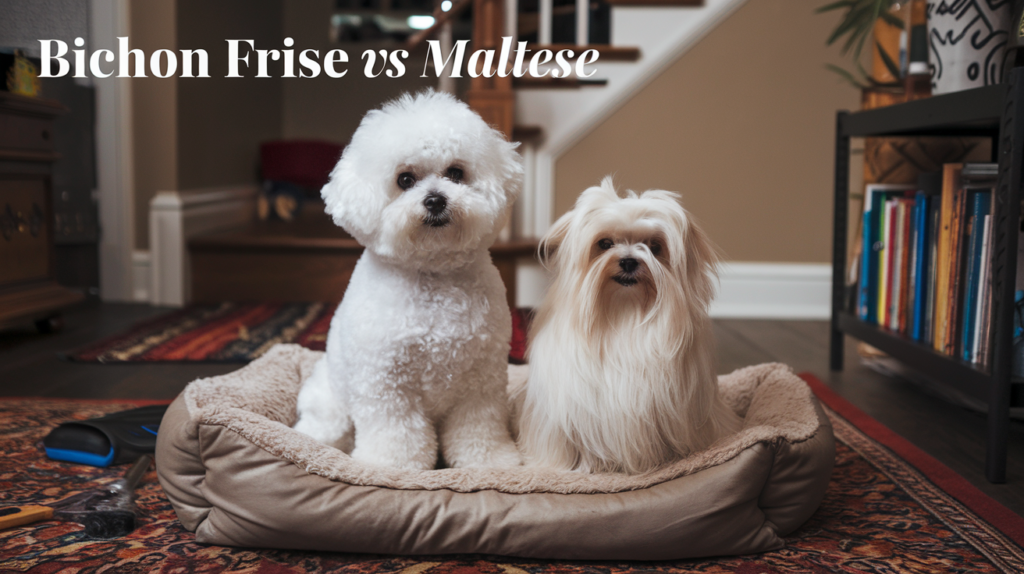Are you ready to embark on a fluffy adventure into the world of adorable toy breeds? 🐾 Meet the Bichon Frise and Maltese – two charming canines that might look similar at first glance but have distinct personalities and needs. While both breeds boast luxurious white coats and irresistible puppy-dog eyes, choosing between them can be quite the challenge for potential pet parents.
Imagine bringing home a furry companion that’s not only adorable but also fits perfectly into your lifestyle. But here’s the catch: how do you decide between the playful Bichon Frise and the sensitive Maltese? From their physical characteristics to temperament, grooming needs to health considerations, there’s a lot to unpack when comparing these two lovable breeds.
In this comprehensive guide, we’ll delve into the seven key aspects that set the Bichon Frise and Maltese apart. Whether you’re a first-time dog owner or looking to add another furry friend to your family, we’ll help you navigate the unique traits of each breed. Get ready to discover which of these delightful dogs might be your perfect match! 🐶💖
Advertisement
Physical Characteristics

Advertisement
Both breeds are small, but the Bichon Frise is slightly larger. Maltese typically stand 20-25 cm tall and weigh around 3 kg, while Bichons are 22-27 cm in height and weigh 3-5 kg. These compact sizes make them ideal for apartment living and lap dog companionship. Now that we’ve covered their physical dimensions, let’s explore their unique temperaments and personalities.
Temperament and Personality
Advertisement

Now that we’ve explored the physical characteristics of these charming breeds, let’s delve into their temperaments and personalities.
Energy levels and playfulness
Both Bichon Frises and Maltese are known for their lively and playful nature. Maltese dogs have medium to high energy levels, requiring over 30 minutes of daily exercise. Bichon Frises are equally energetic, needing at least an hour of activity each day. Their playful demeanors make them excellent companions for families seeking an engaging pet.
Affection towards owners
These breeds are renowned for their affectionate nature. Maltese thrive on human interaction and are excellent lap dogs, forming strong bonds with their owners. Bichon Frises are equally loving, bringing joy to their families with their cheerful personalities. Both breeds crave companionship and may experience separation anxiety if left alone for extended periods.
Interaction with children and other pets
While both breeds can be good family pets, they have different levels of compatibility. Bichon Frises are generally more family and child-friendly, adapting well to various household dynamics. Maltese, although affectionate, require more careful supervision around young children due to their small size and potential fragility. Both breeds can get along with other pets when properly socialized.
Adaptability to different living environments
These small dogs excel in adapting to various living situations. Both Bichon Frises and Maltese are well-suited for apartment living and don’t require large yards. Their compact size and moderate exercise needs make them ideal for urban dwellers or those with limited space. However, they do best in environments where they receive ample attention and companionship throughout the day.
With their charming personalities established, we’ll next explore the grooming and maintenance requirements for these adorable white fluff balls.
Grooming and Maintenance

Now that we’ve explored the temperament and personality of these charming breeds, let’s delve into their grooming needs. Both Bichon Frises and Maltese require intensive grooming routines to maintain their luxurious coats.
A. Coat care requirements
Daily brushing is essential for both breeds to prevent matting. Their white coats need regular attention to stay clean and tangle-free.
B. Bathing frequency
Regular baths are necessary for both breeds, though the exact frequency may vary based on individual needs and lifestyle.
C. Tear staining management
Both Bichon Frises and Maltese are prone to tear staining, which requires careful cleaning and maintenance to keep their facial area pristine.
D. Professional grooming needs
Periodic haircuts and professional grooming sessions are recommended for both breeds to maintain their coat’s health and appearance.
With proper grooming habits established, it’s important to consider the health aspects of these breeds, which we’ll explore in the next section.

Now that we’ve covered grooming and maintenance, let’s delve into the health considerations for Bichon Frises and Maltese dogs. Both breeds are generally healthy, with lifespans ranging from 12 to 15 years. However, they’re prone to certain genetic health issues that potential owners should be aware of. Regular veterinary check-ups are crucial for early detection and management of these conditions. As we transition to discussing training and intelligence, it’s important to note that maintaining good health through proper exercise and nutrition plays a significant role in a dog’s ability to learn and respond to training.
A. Common genetic health issues
Both Bichon Frises and Maltese are susceptible to various health problems. Bichon Frises commonly face allergies, eye conditions like cataracts and glaucoma, dental disease, and orthopedic issues such as hip dysplasia and luxating patellas. Maltese dogs are prone to similar issues, with particular emphasis on dental problems and luxating patellas.
B. Lifespan comparison
Bichon Frises typically live between 12 to 15 years, with some reaching up to 19 years with proper care. Maltese dogs have a similar life expectancy, generally ranging from 12 to 15 years. Both breeds can enjoy long, healthy lives with appropriate care and regular veterinary attention.
C. Exercise requirements
Both breeds have moderate energy levels and require regular exercise to maintain their health and prevent obesity. Daily walks and playtime are essential for both Bichon Frises and Maltese dogs. These activities not only keep them physically fit but also provide mental stimulation, which is crucial for their overall well-being.
D. Dietary needs and sensitivities
Proper nutrition is vital for both breeds. Bichon Frises are prone to allergies and may require special diets to avoid triggers. Both breeds can be susceptible to obesity, so portion control and a balanced diet are crucial. Regular consultations with a veterinarian can help determine the appropriate feeding guidelines and nutritional needs for each individual dog.
Training and Intelligence

Now that we’ve covered health considerations, let’s explore the training and intelligence aspects of these breeds.
A. Ease of training
Both Maltese and Bichon Frise are trainable, but require different approaches. Maltese can be stubborn, needing patience and consistency, while Bichons respond well to positive reinforcement. Bichons are generally easier to train, though they may face challenges with housebreaking due to their excitable nature.
B. Problem-solving abilities
Both breeds demonstrate intelligence, with Maltese known for their emotional intelligence and alertness. Bichon Frises exhibit good problem-solving skills, especially when trained early.
C. Responsiveness to commands
Maltese can be difficult to train due to their stubbornness, while Bichon Frises are eager to please and generally more responsive to commands.
D. Potential behavioral issues
Both breeds require early socialization to prevent behavioral issues. Maltese may exhibit anxiety around strangers, while Bichons dislike being left alone for extended periods.
With this understanding of their trainability and intelligence, let’s explore their suitability as family pets.
Suitability as Family Pets

Now that we’ve explored their training and intelligence, let’s consider how Bichon Frises and Maltese dogs fare as family pets.
Apartment living compatibility
Both breeds excel in smaller living spaces, making them ideal for apartments. Their compact size and moderate exercise needs allow them to thrive in urban environments.
Noise levels and barking tendencies
While generally quiet, both breeds may bark at perceived threats. Early socialization and training can help manage their vocal tendencies, ensuring they remain good neighbors in close quarters.
Time commitment for care
These breeds require significant time for grooming and companionship. Daily brushing, regular baths, and ample attention are necessary to keep them happy and healthy.
Travel-friendliness
Their small size makes them excellent travel companions. However, their attachment to their owners may lead to separation anxiety, so proper preparation is crucial for smooth travels.
With these factors in mind, next, we’ll explore the cost considerations associated with owning a Bichon Frise or Maltese.
Cost Considerations

Now that we’ve explored the suitability of Bichon Frises and Maltese as family pets, let’s delve into the financial aspects of owning these breeds. Understanding the cost considerations is crucial for potential owners to make an informed decision.
A. Initial purchase price
The initial cost of acquiring a Bichon Frise can vary significantly. Adoption fees from shelters or rescue organizations typically range from $300 to $600, offering a more affordable option. However, purchasing from a reputable breeder can cost between $1,200 and $3,500, depending on factors such as the breeder’s reputation and the puppy’s pedigree.
B. Ongoing grooming expenses
Grooming is a significant recurring expense for Bichon Frise owners. Professional grooming sessions, recommended 6 to 10 times a year, can average around $420 annually. This regular maintenance is essential to keep their fluffy white coat in optimal condition and prevent matting.
C. Health care costs
Health care expenses for a Bichon Frise can be substantial. First-year medical costs are estimated between $385 and $795, with annual expenses thereafter ranging from $280 to $645. Potential health issues like hip dysplasia, hereditary cataracts, and dental problems may incur additional treatment costs ranging from $500 to $3,000.
D. Insurance premiums
Given the potential health issues and associated costs, pet insurance is a valuable consideration for Bichon Frise owners. While premiums vary, insurance can help manage unexpected veterinary expenses and provide peace of mind for owners. The cost of insurance should be factored into the overall budget for owning this breed.

Both Bichon Frises and Maltese dogs are charming toy breeds that make wonderful companions, each with their own unique characteristics. While Bichon Frises are slightly larger, more energetic, and better suited for families with young children, Maltese dogs are smaller, more laid-back, and form closer bonds with their owners. Both breeds require regular grooming, have similar health considerations, and adapt well to apartment living.
When choosing between a Bichon Frise and a Maltese, consider your lifestyle, living situation, and preferences. Both breeds offer love, companionship, and joy to their owners, but it’s essential to understand their specific needs and temperaments to ensure a perfect match. Whichever breed you choose, remember that proper care, training, and attention will result in a loyal and affectionate furry friend for years to come.

